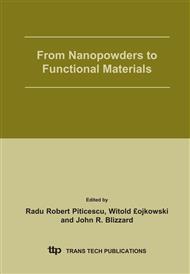p.27
p.31
p.35
p.41
p.47
p.57
p.63
p.75
p.79
Hybrid HAp-Maleic Anhydride Copolymer Nanocomposites Obtained by In Situ Functionalisation
Abstract:
The aim of the work is to establish if maleic anhydride copolymer acts as a grain growth modulator and/or as a biocompatible functionalisation agent for hydroxyapatite. Experimental work was developed in three directions: nanocomposites synthesis, nanocomposites characterization and citotoxicity tests on nanocomposites. Maleic anhydride copolymer – HAp nanocomposites were prepared by in situ functionalisation in hydrothermal conditions and were characterized by chemical quantitative analysis, XRD, FT-IR, SEM, specific surface area and picnometric densities. Chemical bonding between the copolymer carboxyl groups and calcium ions of HAp induced a peak of 1577 cm-1 on the FT-IR analysis. Following the evolution of this characteristic peak with the hydrothermal synthesis conditions (different temperatures and pressures) and corroborates the results with XRD and SEM analysis it was pointed out the copolymer grain growth modulator behaviour. Citotoxicity studies in vitro on mice fibroblast cultures were performed. The results proved the biocompatibility of new hybrid –polymer nanocomposites.
Info:
Periodical:
Pages:
47-56
Citation:
Online since:
September 2005
Price:
Сopyright:
© 2005 Trans Tech Publications Ltd. All Rights Reserved
Share:
Citation:


